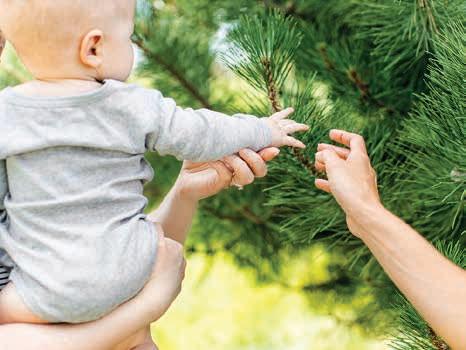
3 minute read
The benefi ts of bringing your baby outside
The benefits of bringing your baby outside
By Lovevery – Lovevery.co.uk Stage-based play essentials for your child’s developing brain
Advertisement
Have you ever noticed your baby’s mood lift when you take them outside? Sunshine and fresh air have well-documented benefits, but being outside is good for your baby for other reasons, too. Their senses are stimulated by vibrant colours, new scents, and exciting sounds like birds and aeroplanes. Spending time outside can also improve language skills – and maybe even their sleep.
If you don’t happen to have immediate access to nature, don’t worry about your baby missing out. Simply being outside in the midst of a busy city can give your baby as many benefits as a walk in the forest, even if it feels a little different.
Here are some of the many reasons to take your baby outside:
New sensations lead to brain development
New sights, sounds, smells, and textures are enjoyable and exciting for your baby. Even if they’re strapped to your chest or reclining in a stroller, they receive all kinds of stimulation outside that they don’t get when they’re indoors. This stimulation also helps build the synapses – connections between cells in your baby’s brain – that are crucial to cognitive development. Even just a walk around a city block can offer as many distinct, new and unpredictable sensations as a walk in the woods.
New language
Spending time with your baby outside also provides new opportunities for language development. As you walk around, narrate what you see and try to react to your baby’s sounds and gestures. Known as ‘serve and return’, this kind of early ‘conversation’ with your baby can have a major impact on their language and cognitive development.

One study found that infants and babies are more likely to try to verbalise experiences they’ve had outdoors, stating: “When an infant feels the leaves or the toddler notices the aeroplane in the sky, they are more inclined to verbalise this experience because it will elicit a favourable response from their caregivers.”
If your baby looks at a tree, for example, get close and invite them to reach out a hand to touch it, describing what they’re seeing and feeling: “you’re touching the bark of the tree. It feels rough, doesn’t it? The bark helps protect the tree.” If your baby reacts to a sound, try to find the source and name and describe it; if something captures their gaze, try to investigate.
Better sleep
Exposure to sunlight plays an important role in how our bodies secrete melatonin, often referred to as the ‘sleep hormone’. A study in the Journal of Sleep Research found that “babies who slept well at night were exposed to significantly more light in the early afternoon period.” Particularly if you have a fussy baby, time outdoors in the afternoon – leading up to the ‘witching hour’ (late afternoon into evening) – can help regulate their sleep-wake cycle. Exposure to direct sunlight can help establish your baby’s circadian rhythms more quickly than if they’re indoors all day.
How to dress them
A few considerations and rules of thumb can tell you when it’s safe to bring your baby outside, and how to dress them for hot or cold weather. Here are some to keep in mind:
Babies can’t cool off the way we do; their sweat glands take time to develop. When it’s hot out (above 23C), the key is to avoid as much direct sun exposure as possible, with a hat on your baby’s head and a sun shield on the carrier or stroller. The FDA doesn’t suggest sunscreen for babies of six months and under. Instead, limit outdoor time when it’s hot (particularly between 10am and 4pm), avoid direct sunlight, and dress your baby in a single layer. Babies should not be outside for prolonged periods of time when the temperature is over 32C.
Babies also lose heat faster than adults, so they get cold more easily. Dressing your baby in layers is best: you can add or remove each layer as needed, and heat gets trapped between them, keeping your baby warm. Don’t forget their feet, hands, and face when you’re dressing your baby for cold weather, and use a blanket if the temperature is particularly low. Babies can overheat easily, even in cold temperatures, so always keep an eye on them when you’re out – and be sure to remove the layers when you get back indoors.







